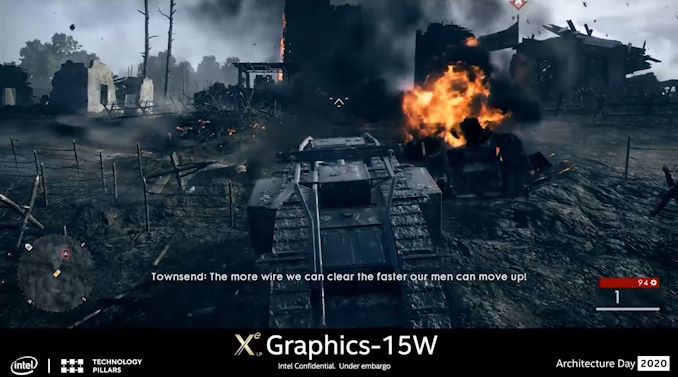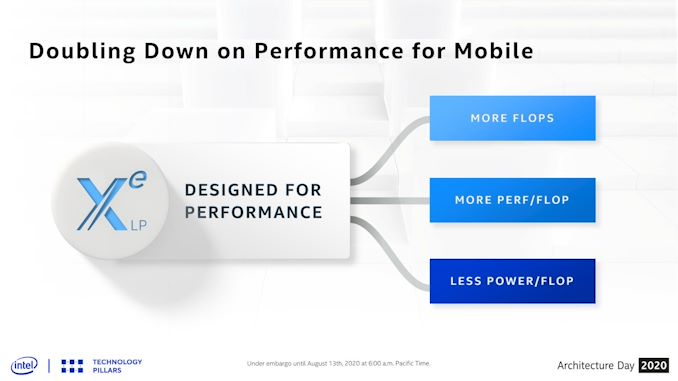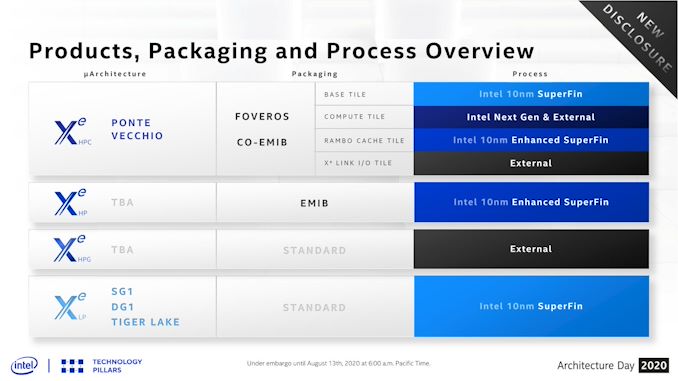The Intel Xe-LP GPU Architecture Deep Dive: Building Up The Next Generation
by Ryan Smith on August 13, 2020 9:00 AM EST- Posted in
- GPUs
- Intel
- Tiger Lake
- Xe
- Xe-LP
- DG1
- Intel Arch Day 2020
- SG1
Performance Expectations & First Thoughts
Wrapping up this GPU architecture deep dive, while Intel didn’t use this year’s architecture day to discuss specific products and SKUs, the company did take a moment to discuss performance expectations for Xe-LP, and offer some quick videos of Xe-LP in action. Unfortunately we weren’t allowed to record these demos (least someone leak them), but we’ll post them here as soon as Intel releases copies to the public.
At any rate, as previously discussed, Intel’s goal was to double Ice Lake’s (Gen11) graphics performance, which Xe-LP will be accomplishing via a combination of a wider GPU (more hardware), a more power-efficient GPU (allowing higher clocks), and a more throughput-efficient GPU (higher IPC). This is a lofty goal given the fact that they don’t get the benefit of a wholly new process node, but Intel does seem rather confident about the performance potential of its new 10nm SuperFin process node, as well as the payoff from the tried-and-true method of brute forcing things by throwing more hardware at it.
Looking at our own performance data from reviews of Ice Lake and Ryzen 3000 “Renoir” laptops, if Intel can meet their performance goals then Tiger Lake should be able to pull ahead of AMD’s comparable U-series Ryzen APUs. As always, this is going to be game-dependent, but high-end Ice Lake laptops were never behind by more than 30% or so in GPU-limited scenarios. But since we’re talking about mobile scenarios, the power and cooling will always be a potential wildcard that can hold a laptop back. So for ultraportable gaming laptops in particular, Intel will undoubtedly want its partners to build laptops with the cooling capabilities to match, to give Tiger Lake every possible chance to succeed.
Framerates aside, Intel also expects Xe-LP’s performance to significantly raise the bar on image quality. With integrated graphics generally bringing up the rear in terms of image quality in order to deliver the necessary framerates, doubling their iGPU performance would allow a lot of games to be run at higher image quality settings. This again would vary from game to game, but at least for promotional purposes, Intel is eyeballing Tiger Lake/Xe-LP being able to run at high image quality in games where Ice Lake could only manage low.
But Xe-LP isn’t just an integrated graphics solution: it’s for discrete graphics too. And while we eagerly anticipate more information on DG1, given Intel’s focus today on architecture over products, we’re left with more questions than answers. Intel has a very interesting and OEM-friendly plan in place with Xe-LP, and by leveraging the same architecture for both the iGPU and an optional discrete GPU, OEMs are going to love the fact that they don’t have to validate and load separate GPU drivers for the integrated and discrete GPUs.
Most importantly, however, Intel is also refusing to answer the 10 million pixel question: will Tiger Lake’s iGPU be able to work in concert with the DG1? Intel has certainly not made any efforts to shoot down that idea, but they also aren’t confirming it, either. And even then, if they utilize mutli-GPU rendering, will they get it right? Multi-GPU rendering on the desktop is all but dead, and for good reason: it tends not to play nicely with certain modern rendering techniques, and it can add a fair bit of input lag. The answer to this question – and whether Intel has been able to conquer the traditional drawbacks of multi-GPU rendering – will absolutely have a huge impact on the commercial viability of the DG1 GPU. So we’ll be eagerly awaiting the answer to those questions.
Otherwise, Xe-LP marks an important step in the evolution of Intel’s GPU architectures, never mind a huge stepping stone in their plans to become a top-to-bottom GPU supplier. Though only destined for laptops, Xe-LP is the basis of something much bigger for Intel: Xe-LP will be the foundation of an entire generation of GPUs to come. So what Intel does here with regards to features, architecture, and above all else power efficiency will have enormous repercussions to come, for everything from gaming hardware to supercomputers. In many ways it’s the dawn of a new era for Intel, and one they are hoping will be a better era than what they leave behind.


























33 Comments
View All Comments
regsEx - Thursday, August 13, 2020 - link
HPG will use EM cores for ray tracing?Mr Perfect - Thursday, August 13, 2020 - link
"On the capacity front, the L3 cache can now be as large as 16MB"I apologize for being off topic, but I just had a surreal moment realizing that this piddly little iGPU can have the same amount of L3 cache as my Voodoo 3 had video ram. How far we've come.
Brane2 - Thursday, August 13, 2020 - link
As usual, no useful info.They'll make a GPU that looks every bit like... GPU.
What a shocker.
Who knew ?
GreenReaper - Thursday, August 13, 2020 - link
"As a result, integer throughput has also doubled: Xe-LP can put away 8 INT32 ops or 32 INT16 ops per clock cycle, up from 4 and 16 respectively on Gen11." -- but the graph says 4 and 8 respectively on Gen11. (The following line also appears odd as a result.)Ryan Smith - Thursday, August 13, 2020 - link
Thanks! That was meant to be 16 ops for Gen11 in the table.neogodless - Thursday, August 13, 2020 - link
> from reviews of Ice Lake and Ryzen 3000 “Renoir” laptops,It is my understanding that the Renoir codename refers to what are commercially Ryzen 4000 mobile APUs, like the 4700U, 4800H and 4900HS.
FullmetalTitan - Thursday, August 13, 2020 - link
In addition to groaning at the joke at the end of page 1, I find the timing to be perfect as I just last night got my partner to start watching the Stargate seriesValantar - Friday, August 14, 2020 - link
As always here on AT, an absolutely excellent article, distilling a pile of complex information down to something both understandable and interesting. I'm definitely looking forward to seeing how Tiger Lake's Xe iGPU performs, and the DG1 too. I doubt their drivers will be up to par for a few years, but a third contender should be good for the GPU market (though with a clear incumbent leader there's always a chance of the small fish eating each other rather than taking chunks out of the bigger one). Looking forward to the next few years of GPUs, this is bound to be interesting!onewingedangel - Friday, August 14, 2020 - link
The approach taken with DG1 seems a little odd. It's too similar to the iGPU by itself, just with more power/thermal headroom and less memory contention.Unless it works in concert with the IGP, you'd think it better to either remove the iGPU from the CPU entirely (significantly reducing die size) and package DG1 with the CPU die when a more powerful GPU is not going to be used, or to add a HBM controller to the CPU and make the addition of a HBM die the graphics upgrade option when the Base iGPU is not quite enough.
Digidi - Friday, August 14, 2020 - link
Nice article! The Fron end look huge. 2 Rasterizer for only 700 Shaders is a massive Change.